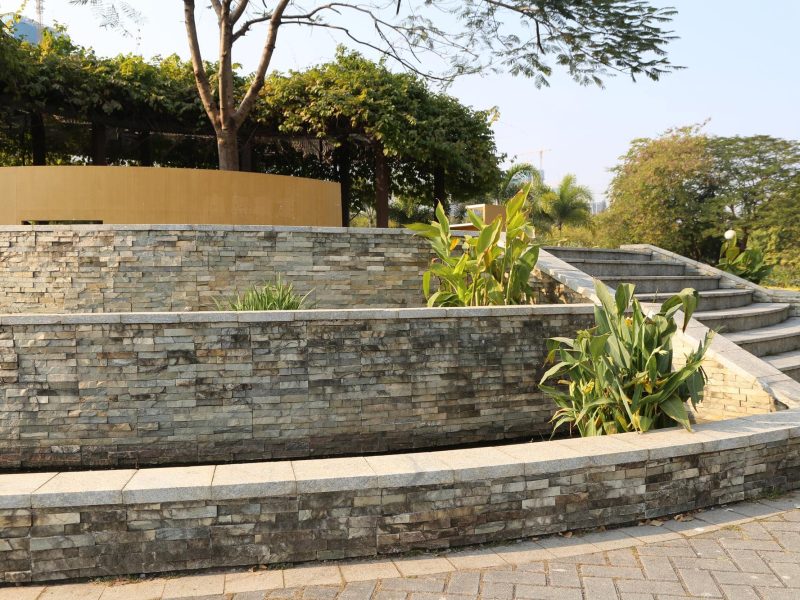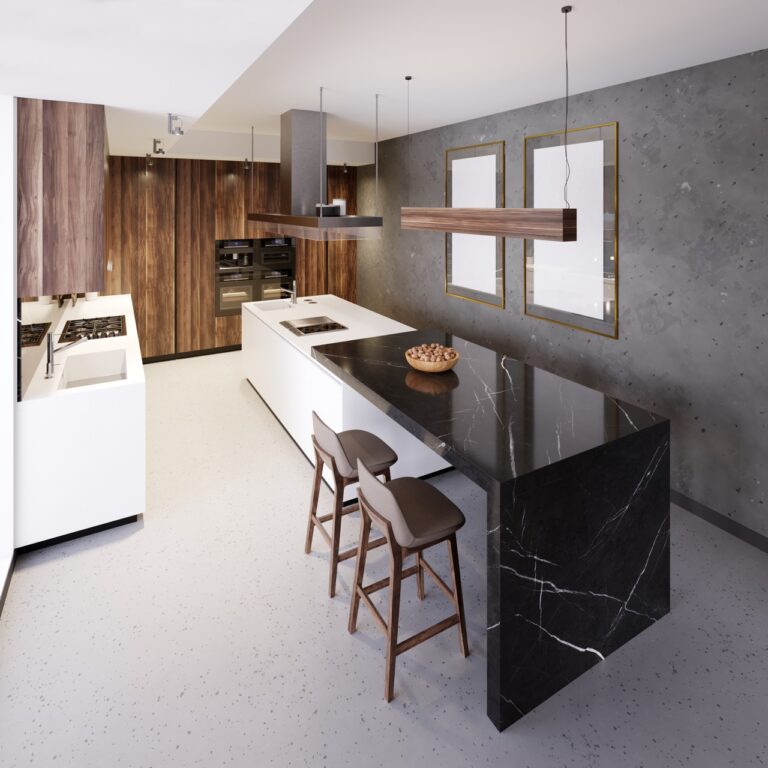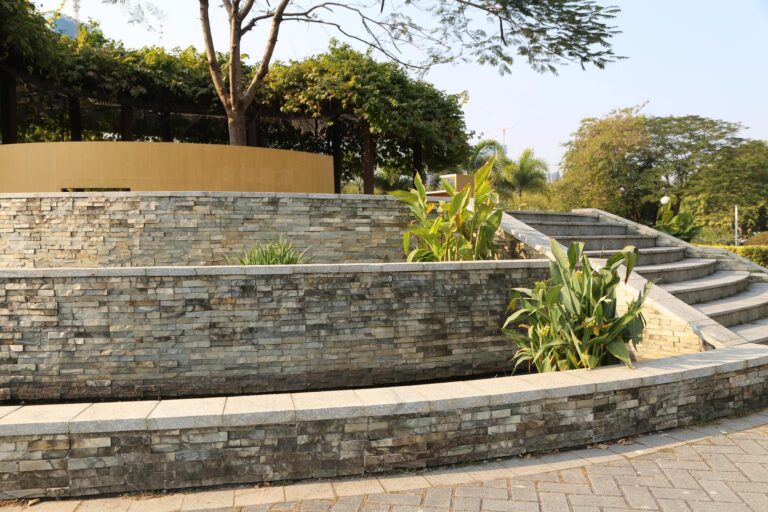A well-built retaining wall does far more than hold back soil, it defines your landscape, protects your property from erosion, and adds visual appeal. In Arlington, TX, where changing weather and uneven terrain can challenge outdoor spaces, a strong retaining wall is both a functional necessity and a design feature.
Homeowners often underestimate the importance of hiring experienced retaining wall contractors who understand local soil conditions, drainage, and construction materials. This guide explains how retaining walls improve property strength and style, what to expect from professional installation, and how to choose the right experts for lasting results.
Why Retaining Walls Are Essential for Arlington Homes
Retaining walls provide stability on sloped yards, protect foundations, and add structure to landscaping. In Arlington’s mixed clay soils, heavy rainfall and shifting ground can create pressure that leads to soil erosion or foundation cracks if walls are not properly constructed.
Professionally installed residential retaining walls in Arlington TX help prevent these issues by supporting soil, guiding drainage, and defining outdoor spaces like gardens, patios, and driveways. They also improve curb appeal, increasing property value and safety at the same time.
Types of Retaining Walls for Every Property
Choosing the right type of wall depends on your yard’s slope, soil type, and design goals. The most common residential retaining wall styles include:
Key points to remember
- Gravity walls: Rely on their own weight using concrete or stone to resist soil pressure.
- Cantilevered walls: Use reinforced concrete and steel bars for extra support.
- Sheet pile walls: Ideal for tight spaces or areas with soft soil.
- Anchored walls: Include tiebacks driven into the soil for heavy loads or steep slopes.
- Segmental block walls: Attractive and durable interlocking blocks, perfect for modern landscapes.
Understanding these options helps you work with your contractor to choose materials and designs that fit your home’s layout. For more insight into which design works best, you can review professional project advice.
Materials That Combine Strength and Style
Retaining walls can be built from many materials, each offering unique advantages in durability, maintenance, and appearance.
Natural stone gives a timeless look that blends seamlessly with outdoor surroundings. Concrete blocks are cost-effective and highly customizable, while brick or decorative stone veneer adds elegance. In some properties, timber may be used for short garden walls, although it requires more maintenance than masonry materials.
When selecting materials, think about the overall aesthetic of your home, modern, rustic, or traditional, and your maintenance preferences. You can discover helpful design resources here for ideas on material combinations that enhance your property’s landscape.
Drainage: The Hidden Hero of Every Retaining Wall
Proper drainage ensures the long-term stability of retaining walls. Without it, trapped water increases soil pressure, leading to cracks or wall movement. Seasonal rainstorms make this step critical for any residential installation.
Key points to remember
- Use drainage pipes or gravel backfill to channel water away from the wall.
- Install weep holes to relieve hydrostatic pressure.
- Ensure the slope directs water runoff safely.
- Combine waterproof membranes with backfill for added protection.
Your contractor should include a detailed drainage plan in every project proposal. This single step can extend the lifespan of your wall by decades. Learn more about smart construction planning through local service expertise.
Signs You Need Retaining Wall Repair or Replacement
Even the strongest wall requires maintenance over time. Homeowners should inspect their retaining walls annually, especially after heavy rain or soil movement.
Look for early warning signs that repairs may be needed:
- Visible cracks or leaning sections
- Soil washing out near the base
- Bulging or separating joints
- Pooled water behind or around the wall
Addressing these issues early prevents costly replacements later. For professional guidance, you can find detailed retaining wall insights to help assess your structure’s condition.
The Value of Hiring Experienced Retaining Wall Contractors
Attempting to build or repair a retaining wall without professional help can lead to serious problems. Experienced retaining wall contractors in Arlington TX bring specialized knowledge about soil mechanics, slope angles, and proper reinforcement.
They ensure compliance with local building codes, use high-quality materials, and follow proven engineering practices. A licensed contractor will also manage excavation, drainage, and permit requirements, saving you time and potential legal headaches.
In short, the right team guarantees your retaining wall not only looks beautiful but performs reliably under pressure.
How to Choose the Best Contractor for Your Project
Selecting the right professional for your residential retaining wall in Arlington TX involves more than just comparing prices.
Key points to remember
- Check licensing and insurance: Always verify credentials to ensure your contractor meets Texas regulations.
- Review past projects: Look for consistency in design quality and craftsmanship.
- Ask about warranties: Reliable contractors guarantee both materials and labor.
- Get detailed estimates: Request itemized quotes outlining labor, materials, and timeline.
- Evaluate communication: Clear, honest communication prevents confusion during construction.
Doing your research before signing a contract ensures your investment produces long-term value. For additional contractor selection tips, explore regional remodeling guidance.
Designing Retaining Walls That Enhance Curb Appeal
Modern retaining walls are as much about style as structure. The right design complements your home’s architecture and landscaping. Consider tiered retaining walls to add depth to your yard, or curved layouts for a softer visual flow.
Incorporating integrated lighting, planters, or seating turns functional retaining walls into decorative features. When designed strategically, they can transform a simple yard into a polished outdoor retreat.
To see how wall designs align with your property’s unique style, you can review creative outdoor solutions.
Cost Factors and Budget Planning
The cost of retaining wall installation varies based on materials, design complexity, and site conditions. On average, homeowners can expect a broad range depending on size, material type, and drainage requirements.
Key points to remember
- Concrete and interlocking blocks offer affordability and strength.
- Natural stone walls cost more but provide unmatched beauty.
- Drainage and reinforcement add to upfront costs but prevent expensive repairs later.
- Hiring experienced local contractors ensures accurate site assessment and fair pricing.
When comparing estimates, focus on value rather than the lowest price. Investing in professional construction ensures durability and safety for years to come.
Maintenance Tips for Long-Lasting Retaining Walls
Proper maintenance keeps your retaining wall performing its function for decades. Inspect the wall regularly for cracks or soil movement and address minor issues before they worsen.
Clean surfaces with mild detergent and water, and keep drainage channels clear of debris. Trim nearby trees and shrubs to prevent root pressure on the wall. With regular care, your retaining wall will remain a durable and attractive feature of your property.
Conclusion
A strong, well-designed retaining wall combines beauty, stability, and protection for your home’s landscape. Whether you’re building a new structure or repairing an older one, choosing skilled retaining wall contractors ensures your project stands the test of time. With thoughtful material selection, proper drainage, and experienced craftsmanship, you can create a wall that enhances curb appeal and safeguards your property.
When you’re ready to plan your project, you can connect with experienced professionals who understand the unique needs of Arlington homes. To see local examples and learn more about reliable solutions, browse helpful service information or explore regional design inspiration before starting your next outdoor upgrade.
Frequently Asked Questions
1. Why are retaining walls important for Arlington homes?
They prevent soil erosion, manage drainage, and add visual structure to sloped or uneven landscapes.
2. What materials are best for residential retaining walls?
Concrete blocks, stone, and brick veneer offer durability, while timber works for short garden walls with proper maintenance.
3. How long does a retaining wall last?
With quality materials and professional installation, most retaining walls last 25 to 50 years or longer.
4. Do I need a permit to build a retaining wall?
Yes, most walls over a certain height or near property lines require city permits and inspection.
5. How can I tell if my retaining wall needs repair?
Look for leaning sections, cracks, or water pooling behind the wall—these indicate structural pressure or drainage issues.
6. How much does a typical retaining wall project cost?
Costs vary based on size and materials, but local contractors can provide accurate estimates after site evaluation.
7. What type of wall is best for steep slopes?
Anchored or cantilevered walls provide strong support for steep or heavy soil conditions.
8. How does drainage affect retaining wall performance?
Proper drainage prevents hydrostatic pressure buildup, which can cause cracks or wall failure.
9. Can I install a retaining wall myself?
DIY walls may work for short garden borders, but professional installation ensures long-term stability for larger projects.
10. How often should retaining walls be inspected?
Inspect annually, especially after heavy rainfall, to catch small issues early and extend wall life.



